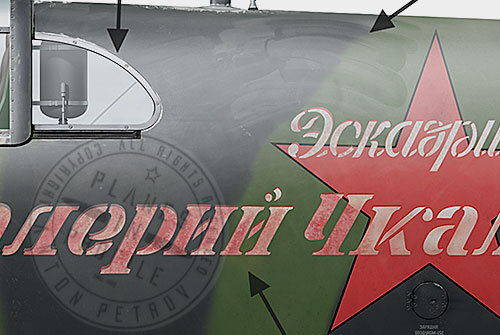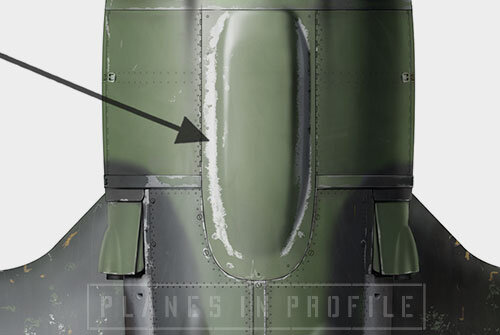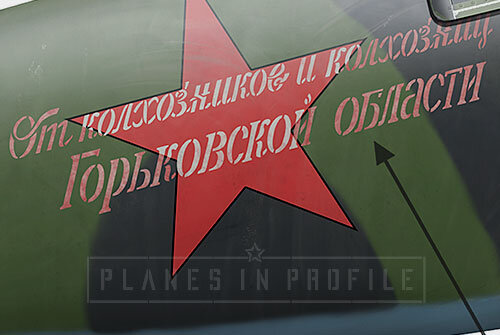(Savitskiy’s?) White-60
LAVOCHKIN, LA-5 (TYPE 37)
3-rd IAK, (possibly) April-May 1943, Kuban
(possibly) Flown by the commander of the 3-rd IAK, General-major Yevgeniy Yakovlevich Savitskiy (Callsign“Dragon” )( Ace with 24 victories (22 personal + 2 shared)) [6]
Yevgeniy Savitskiy was a gifted fighter pilot and a legendary commander who became Marshal of Aviation after the war. He graduated from the 7th Stalingrad Military School of Pilots of the Volga Military District in 1932, at age 21, and worked at the school as a pilot instructor for a couple of years. After joining the army in 1934 Savitskiy’s abilities to ‘command’ quickly progressed him upwards through the ranks and commanding positions, starting with a flight commander of a detachment based in Kiev (Ukraine), then a squadron commander, a regiment commander and eventually a commander of a whole division based in the Far East in 1941, by which time Savitskiy himself was promoted to ‘major’. This is the position he held when the Great Patriotic War began.
Savitskiy was still based in the Far East for about a year after the outbreak of the war, during that time he was given command of the Air Forces of the 25-th Army. But his desire to fight the Germans in the west was so strong that he was willing to give up his high position, just to be relocated to the west, saying:
Had they offered me a squadron, or even just a flight, I would have most likely agreed to it. Damned be the high position, I had no time for ranks - just to fight the enemy, strike him, drive him to hell from our land ! .. And positions can be gained, such a war will not end soon " .[5]
His strong personality helped him to get his wish and he was transferred to the south-west of Russia and then fought in the Battle for Stalingrad, and “as a bonus” got promoted to the rank of a ‘colonel’ and later to ‘general-major’. On the 10th of December, he took command of the 3rd Fighter Aviation Corps, which he led for the rest of the war, flying the Yakovlev Yak-1, Yak-9, Yak-3, and Lavochkin La-7. Until June 1943, the corps fought as part of the North Caucasian Front in the North Caucasus Strategic Offensive, before being withdrawn to the Reserve of the Supreme High Command (RVGK) . It is believed that the photos in which we see Savitskiy with the ‘White-60’ were taken at around the time of this North Caucasus Offensive, in the Kuban bridgehead, the location of some fierce battles between the attacking Red Army and the dug-in German ‘Army Group A’.
A documentary video about Savitskiy, shows the ‘White-60’ supposedly from that time period, with Y. Savitskiy and V. Merkulov in front of it, as well as a downed BF-109. The video voiceover says:
‘The ‘victorious’ airplane (referring to the White-60 presumably) was piloted by the commander of the fighter unit, general-major, comrade Savitskiy.’
Of course the video might have been staged. So it is very difficult to determine whether Savitskiy actually flew the ‘White-60’ or not. It is known that Savitskiy preferred the Yak airplanes and he insisted that his unit be equipped with Yaks when he took charge of forming the 3-rd IAK in late1942/early 1943. Which implies that he most likely flew Yakovlev airplanes during battle action in Kuban around April-May 1943 and his victories from around that time were most likely scored in a Yak. Though some sources seem to suggest that Savitskiy flew a La-5 during the battle action in Kuban in 1943 also. Either way, the victories which were scored by Savitskiy during that time are:
20.04.1943 1 Ju-87 (Stuka) Krymskaya.
05.05.1943 1 BF-109 north of Krymskaya. [6]
The last confirmed victory above is proof that 1 BF-109 was indeed downed by Savitskiy in spring 1943, during the air battles over Kuban, as the documentary video shows.
Noteworthy Visual Characteristics
1) The frame around the back glass panel seems to be unpainted, bare metal.
2) The ‘wipe’ marks are visible in the photo reference in the area indicated by the arrow. These might have been a result of the airplane being stripped off of its winter coating of temporary white paint. Many La-5 airplanes were painted white in winter over the top of their Green/Black camouflage. The La-5s which were built in winter were given this white coating at the factories, with the idea that the white paint will eventually come off by summer time revealing the standard Green/Black summer camo underneath.
Of course the wipe marks might have simply been ‘smeared dust’ rather than a result of the removal of white paint.
3) ‘Эскадрилья Валерий Чкалов’ (Eskadril’ya Valeriy Chkalov)- translates to ‘Squadron Valery Chkalov’. This inscription appeared on the airplanes built with the funds which were raised and donated to the ‘Red Army war fund’ by the workers of the Gorkiy (Today’s Nizhniy Novgorod) region. Many collective farms participated in this ‘fund raiser’ and a total of about 60, 000,000 roubles was raised [1], a further 1.1 million was raised by the Fire Brigades of the Gorkiy region [1b] - astronomical amounts of money for that time. Even schools participated in the collection of funds for the E.V.Ch airplanes, and at least one airplane was known to have been built with these.
These funds were enough to build about 200 airplanes[2], mostly La-5s and some LaGG-3s, which were distributed across many different units, including the 3 IAK, as well as 11 IAP, 21 IAP, 159 IAP, 193 IAP, 4 GIAP KBF, 5 GIAP, 41 GIAP, 111 GIAP, 180 GIAP. [3]
Valeriy Chkalov was a famous Soviet test pilot who died in 1938 during a test flight of a Polikarpov I-180. He was from the Nizhniy Novgorod (former Gorkiy) region, which is why the airplanes bare his name.
Massimo Tessitori did some good research on the ‘Eskadrilya Valeriy Chkalov’ and it’s worth visiting his website HERE to learn more about the “Eskadrilya” and to see his interpretation of the White-60 too which can be found on that same page:)
What appears as traces of white paint indicated in point #4 implies that this plane was painted white previously (winter camo.), which means that the slogan was most likely painted red over white initially (so that it can stand out on the white winter camo.). When the winter camo. was removed, some of the red was probably removed from the slogan too, giving the slogan its ‘patchy’ appearance. This theory seems to explain why the red on the slogan appears so patchy .
4) It appears that traces of the white winter camouflage are still visible in some areas. The most visible seem to be around the canopy joints indicated by ‘4a’, at the base of the air intake indicated by ‘4b’, and at the base of the antena mast indicated by ‘4c’.
The winter camouflage was painted with chalk-based white paint which was removable. In spring the airplanes painted with this paint acquired their ‘distempered’ appearance as a lot of the white paint would start to come off revealing the summer Green/Black camouflage beneath it.
5) ‘От колхозников и колхозниц Горьковской Области’ ( Ot kolkhoznikov i kolkhoznits Gor’kovskoy oblasti) - Translates to ‘From the collective farmers(male) and the collective farmers (female) of the Gorkiy region’.
This inscription usually appeared on the starboard side of the ‘Эскадрилья Валерий Чкалов’ airplanes.
I chose to paint it partially red, believing that it was probably painted similarly to the ‘Eskadril’ya Valeriy Chkalov’ on the other side. Red over white initially, leaving some of the patchy red when the white distemper was removed.
I used a photo of ‘White-99’ and ‘White-40’ as my reference for painting the starboard-side slogan on ‘White-60’. Note that there seems to be a very very faint inscription under the star in the image of ‘White-99’. It doesn’t look like the same inscription appeared under the star of ‘White-40’ so maybe it was unique to ‘White-99’. For this reason I decided to not paint it on ‘White-60’ also.
6) The plane was painted in the standard Green/Black camouflage pattern, based on what can be seen in the photos.
Here are a few close-up images to help illustrate the points above. Full set of close-up images is On Patreon
Footnotes
[1] Based on Stalin’s telegram :
’Please convey my brotherly greetings and gratitude to the collective farmers of the Gorky Region, who have raised 60 million rubles for the Red Army fund to organize the Valery Chkalov combat aircraft squadrons. I. Stalin "
The quote was found here: http://www.chkalovsk-zbs.narod.ru/bibl/75let/Aviaeskadriliya.html
[1b] The sum collected by the firemen is according to the contents of a telegram from Stalin, as described in an image from the National Archive of the Gorkiy Region.
[2] The number of planes is based on the information on page 79 of Miloš Veštšik’s book called ‘Lavockin La-5’, published by MBI in 2006.
[3] The list of regiments which received the Valeriy Chkalov airplanes was taken from the ‘Soviet aerial tactical markings of WWII’ website page. http://www.wio.ru/simbols/sov-en.htm
[4] Based on the information found here: http://airaces.narod.ru/all10/savitsky.htm
[5] This quote was found on this page : http://airaces.narod.ru/all10/savitsky.htm
[6] Based on Mikhail Bykov’s research in the book ‘Все асы Сталина 1936–1953 гг’ [All aces of Stalin 1936-1953] Moscow: Yauza. 2014. ISBN 978-5-9955-0712-3
Summary of LINKS TO THE REFERENCE IMAGES AND VIDEOS
Image 1
http://g2.img-dpreview.com/D321020E2EA441F88F02B792F7D62F49.jpg
Image 2
http://soviet-aces-1936-53.ru/abc/s/savitski7.jpg
Image 3
http://airaces.narod.ru/all10/merkulv4.jpg
Image 4
http://airaces.narod.ru/all10/savitsk4.jpg
Video
10:07 - 10.22
https://youtu.be/yuEwkAVTwCo?t=607
All the work presented on this is page is subject to updates and revisions in the light of new information which might present itself. If you have any new information relevant to this page or disagree with anything that's presented here, then please feel free to contact me through the Planes in Profile Facebook page. Thanks:)





